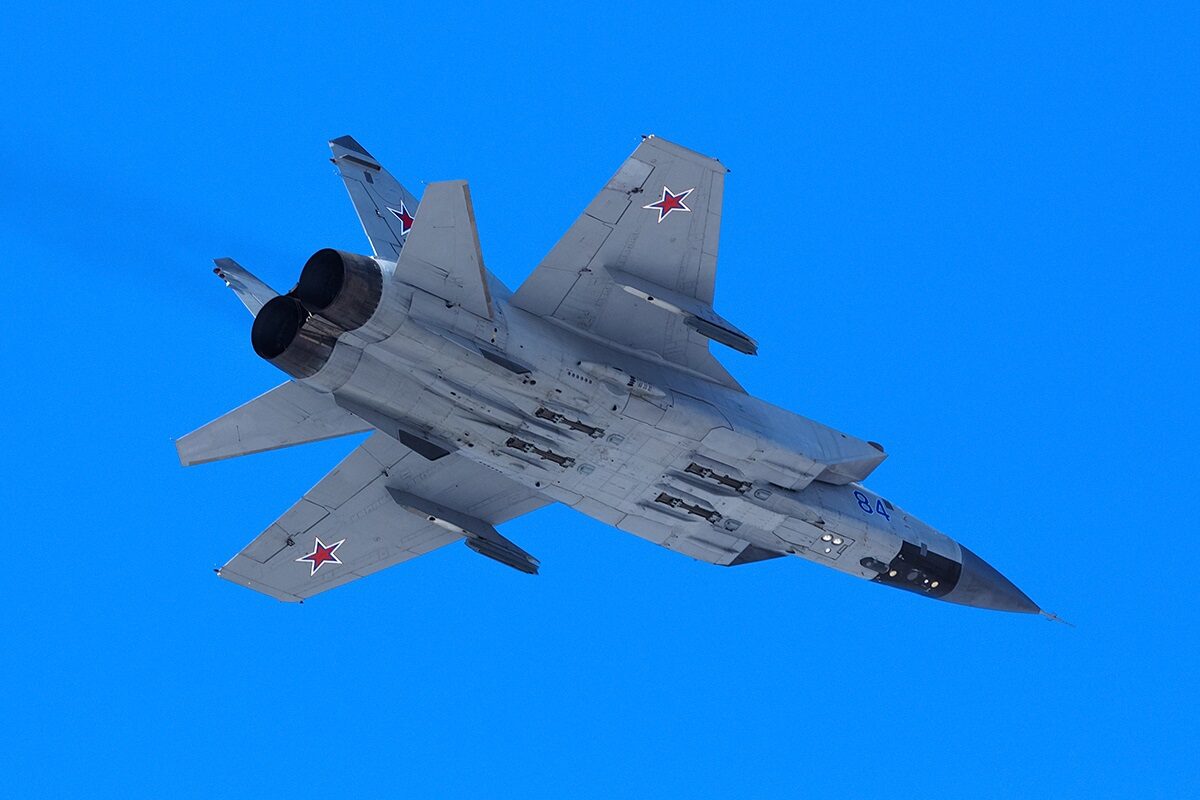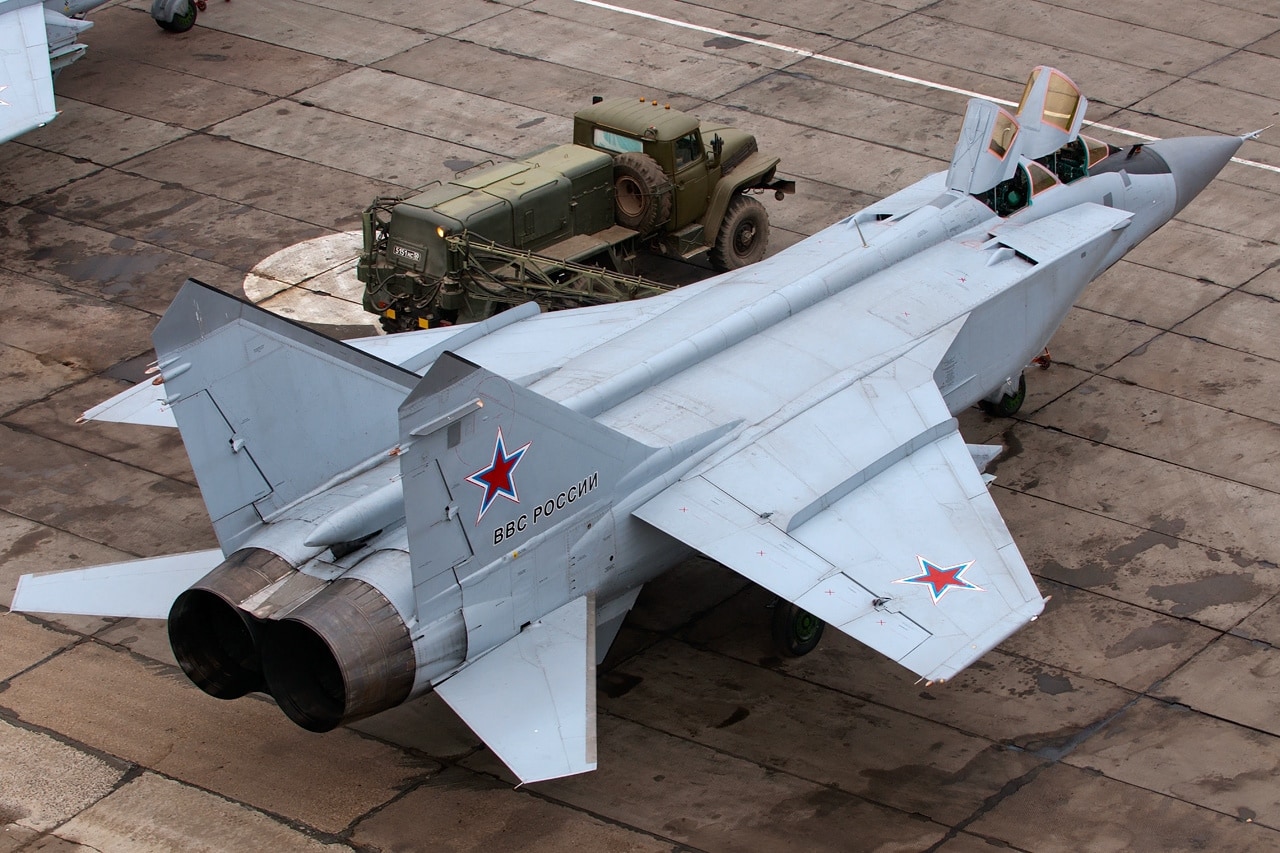Developed at the height of the Cold War, the Soviet-designed MiG-31 interceptor was created with speed as a priority. Despite its age, the MiG-31 has begun to additionally take on a new role as a platform for some of Russia’s advanced hypersonic Kinzhal cruise missiles.
Development of the MiG-31
In order to overcome the inability of the Soviet Union’s older MiG-25 interceptors to fly effectively at supersonic speeds at low altitudes, the Soviet Mikoyan-Gurevich design bureau began the development of the Foxhound in 1968. The aircraft first flew in 1975 and was accepted into service in 1981. By the middle of the 1990s, more than 500 examples of the aircraft had been produced, none of which were exported by the Soviet Union. Today, the only countries which are confirmed to operate MiG-31s and their later variants are Russia, which owns the vast majority of MiG-31 airframes in existence today, and Kazakhstan, which currently owns slightly more than two dozen Foxhounds.
Specs of the MiG-31
Dubbed as the Foxhound under its NATO designation, the two-seat MiG-31 was able to quickly become the Soviet Union’s main interceptor aircraft. The MiG-31’s two D-30F6 engines allow it to reach a maximum speed of Mach 3 at high altitudes, and contribute to the aircraft’s base range of 1,900 miles. In keeping with its long-range and high-altitude air-defense mission, the MiG-31 is equipped with the SBI-16 Zaslon fixed phased array antenna radar, which was one of the world’s most capable at the time. In addition to its Gsh-6-23 23mm cannon, the MiG-31 can carry a variety of combinations of long- and short-range missiles to engage air targets.
Where does the MiG-31 Fit into the Future of the Russian Aerospace Forces?
As of today, the MiG-31 is intended to serve for many more years in the Russian Aerospace Forces, which Moscow hopes to accomplish through the modernization of the aircraft. Despite Russia’s talk of development of a successor to the MiG-31 known as the MiG-41, there is little to suggest that the aircraft will see the light of day anytime soon. Therefore, Russia has opted to create a series of modernized variants of the MiG-31 which will allow the Foxhound to remain in service for many years to come.
Chief among these is the MiG-31BM, which Russian defense industrial base officials claim will include an electric fly-by-wire control system. According to Russian state media, MiG-31BM modernization project began in 2007 and will involve the “complete replacement” of the aircraft’s onboard equipment. In a departure from its traditional role as an interceptor of high-flying bomber or strike aircraft, the MiG-31BM is instead designed around the capability of launching the Kh-47M2 Kinzhal hypersonic air-to-surface ballistic missile, according to Russian media.
However, the main MiG-31-based platform for the Foxhound today appears to be a different variant, which is known as the MiG-31K, which was specially modified to carry them. MiG-31Ks have been used to strike targets early on in Russia’s 2022 invasion of Ukraine with Kinzhals. Russian MiG-31Ks also participated in naval drills off of Syria just weeks before the Ukraine invasion.
Nonetheless, despite Russian plans to continue using the MiG-31 far into the future, the MiG-31 has not been immune to accidents. In 2022 alone, two separate crashes have been officially confirmed by Russia, including one in which a Foxhound skidded off the runway in Novgorod Oblast in January, and a MiG-31 crash due to unspecified “technical malfunction” in April.

Image: Creative Commons.

Image: Creative Commons.
The continued importance of the MiG-31 in Russian military thinking can be seen in Moscow’s promotion of plans to use the MiG-31 to protect projects of high importance to the Kremlin, such as the Northern Sea Route. While less than 100 examples of the Foxhound have reportedly been modernized to the MiG-31BM standard, Russia is likely very keen on maintaining its MiG-31 interceptors into the far future, as long as a distinct replacement is out of sight and the Foxhound platform can still meet Moscow’s requirements.
Wesley Culp is a Research Fellow at the Center for the Study of the Presidency and Congress. He regularly writes on Russian and Eurasian leadership and national security topics and has been published in The Hill as well as in the Diplomatic Courier. He can be found on Twitter @WesleyJCulp.

